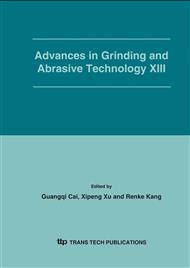p.14
p.19
p.24
p.29
p.33
p.38
p.43
p.48
p.52
Energy Model in Laser Processing of a Cylindrical Grinding Wheel
Abstract:
Laser processing of abrasive grinding wheels is paying a great role in a truing technique to complement mechanical methods. An energy balance model was adopted that took into account the space modes of laser energy absorbed/scattered by the wheel (circular profile). Both geometric and mathematic models were developed to reveal laser processing mechanism and predict various processing parameters, such as incident position, focal offset, and incident power, to perform material removal during laser processing a cylindrical grinding wheel. Moreover, the incident angle for laser processing of small-vitrified CBN grinding wheels was optimized. Further theoretical analysis and experiments determined the focal position of the incident beam with respect to the wheel profile. Experimental studies were carried out using different processing parameters and grinding wheels to test the effects of laser space properties on processing quality. The experimental results were shown to be in reasonable agreement with predicted results.
Info:
Periodical:
Pages:
33-37
Citation:
Online since:
February 2006
Authors:
Price:
Сopyright:
© 2006 Trans Tech Publications Ltd. All Rights Reserved
Share:
Citation:


